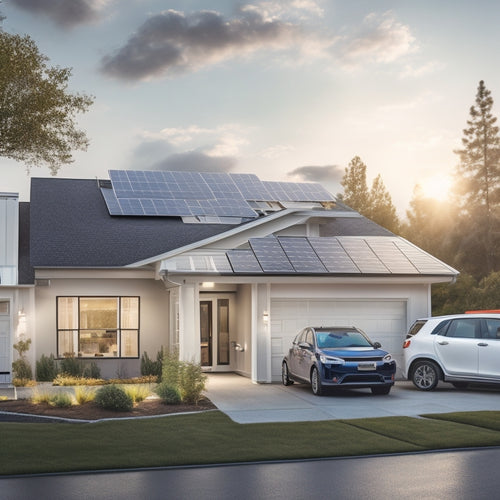
Maximize Energy Harvest With These 5 Strategies
Share
You can maximize your energy harvest with these 5 strategies. First, optimize panel angles and tilt to increase energy production by up to 40%. Next, monitor performance in real-time to identify and address issues promptly. Cleaning your panels regularly is also essential, as accumulated dirt and debris can reduce efficiency by up to 25%. Additionally, identify and eliminate shading and obstructions, which can reduce energy output by up to 50%. Finally, consider upgrading to high-efficiency panels, which can boost energy harvest by up to 20%. By implementing these strategies, you'll be on your way to maximizing your energy harvest - and there's more to explore to take your energy production to the next level.
Key Takeaways
• Optimize panel angles and tilt to increase energy harvest by up to 40% and ensure structural integrity.
• Monitor performance in real-time to identify and address issues before they impact energy harvest.
• Clean panels regularly to maximize energy output, as accumulated dirt and debris can reduce efficiency by up to 25%.
• Identify and mitigate shading and obstructions, which can reduce energy output by up to 50%, by assessing roof topology and surroundings.
• Upgrade to high-efficiency panels to boost energy harvest by up to 20% compared to traditional models.
Optimize Panel Angles and Tilt
By adjusting the angle and tilt of your solar panels, you can increase energy harvest by up to 40%, making this optimization vital for maximizing energy output. To achieve this, it's important to take into account the structural integrity of your solar panel system. Make sure that your panels are securely fastened to the roof or ground, and that the mounting system can withstand environmental stresses like wind and snow.
Properly angled and tilted panels also affect angular momentum, which influences energy production. When panels are aligned with the sun's trajectory, angular momentum increases, resulting in higher energy yields. However, if panels are misaligned, angular momentum decreases, leading to reduced energy output.
To optimize panel angles and tilt, take into consideration your location's latitude, the time of year, and the surrounding environment. By making informed adjustments, you can significantly enhance your energy harvest and maximize your ROI.
Monitor Performance in Real-Time
Tracking your solar panel system's performance in real-time allows you to identify and address potential issues before they impact your energy harvest. With real-time monitoring, you'll be able to detect even slight deviations from peak performance, enabling you to take swift corrective action. By leveraging advanced Data Analytics, you can pinpoint areas of inefficiency and optimize your system's output.
Smart Sensors, strategically installed throughout your solar panel array, provide real-time data on temperature, voltage, and current. This granular data enables you to fine-tune your system, ensuring maximum energy production. For instance, if a sensor detects a slight drop in voltage, you can investigate and rectify the issue before it affects your overall energy harvest.
Clean Panels for Maximum Gain
Regularly maintaining your solar panels is crucial to maximize their energy output. A thin layer of dirt, grime, and debris can accumulate on the panels, reducing their efficiency by up to 25%. This decrease in performance not only impacts your energy harvest but also contributes to a higher carbon footprint. By neglecting this regular upkeep, you're compromising the effectiveness of your solar panels.
To ensure you're getting the most out of your solar panels, it's important to clean them regularly. You can accomplish this task yourself using a soft-bristled brush, mild soap, and distilled water. Alternatively, you have the option to hire a professional to handle the cleaning for you.
Identify Shading and Obstructions
Shading and obstructions can reduce your solar panels' energy output by up to 50%, making it essential to identify and address these issues promptly. You can't maximize energy harvest if your panels are partially blocked or shaded.
To identify potential issues, assess your roof topology, considering factors like surrounding buildings, trees, and architectural features that could cast shadows on your panels. Don't forget to inspect your roof for obstructions like skylights, vents, or chimney stacks that can reduce energy output.
Implementing effective vegetation management is also important. Make sure that nearby trees or plants aren't growing too close to your solar panels, as leaves and branches can block sunlight. Consider trimming or pruning nearby foliage to minimize shading.
Additionally, ensure that your solar panels are installed at an ideal angle and orientation to minimize shading effects. By addressing these potential issues, you can significantly increase your energy harvest and get the most out of your solar panel investment.
Upgrade to High-Efficiency Panels
By upgrading to high-efficiency solar panels, you can boost your energy harvest by up to 20% compared to traditional models. This significant increase in energy production is due to advanced technologies that improve energy density, allowing more power to be generated per unit area.
High-efficiency panels are designed with premium materials and cutting-edge manufacturing processes, ensuring peak performance and durability. In fact, high-efficiency panels often come with enhanced panel durability, reducing the likelihood of degradation over time. This means you can rely on your solar panels to perform at their best for years to come.
When selecting high-efficiency panels, look for models with high energy density ratings, typically measured in watts per square meter (W/m²). By choosing panels with high energy density, you can maximize your energy harvest and get the most out of your solar investment.
With high-efficiency panels, you'll be producing more clean energy and reducing your carbon footprint in no time.
Frequently Asked Questions
Can Energy Harvesting Be Used for Small-Scale Residential Areas?
You can leverage energy harvesting for small-scale residential areas, like neighborhood installations, to reap community benefits, such as reduced energy costs and a more sustainable living environment, ultimately enhancing your neighborhood's overall quality of life.
How Often Should Energy Harvesting Systems Be Inspected?
You should establish maintenance schedules with regular inspection frequencies to guarantee peak energy harvesting system performance, typically every 3-6 months, or as recommended by the manufacturer, to detect potential issues early on.
Are Energy Harvesting Systems Compatible With Existing Infrastructure?
You'll find that energy harvesting systems are often compatible with existing infrastructure, but may require a system integration process to guarantee seamless operation, and in some cases, a partial infrastructure overhaul to optimize performance.
Can Energy Harvesting Systems Be Used in Remote or Off-Grid Areas?
You can deploy energy harvesting systems in remote or off-grid areas, perfect for rural electrification and island communities, where traditional infrastructure is limited, and energy independence is vital.
Are Government Incentives Available for Energy Harvesting Systems?
As you venture into the world of energy harvesting, you'll find that government incentives await, like a golden fleece, offering tax credits and grant funding to fuel your sustainable endeavors, making your eco-friendly dreams a reality.
Related Posts
-

What Electric Vehicle Owners Need for Home Energy
As an electric vehicle owner, you need to optimize your home energy system to guarantee efficient, sustainable, and c...
-

Why Choose Solar Car Battery Charging Systems?
You're switching to a cleaner, more sustainable transportation option by choosing solar car battery charging systems,...
-

Eco-Friendly Car Battery Solutions Available Online
You can now shop online for eco-friendly car battery solutions that not only reduce your carbon footprint but also of...


